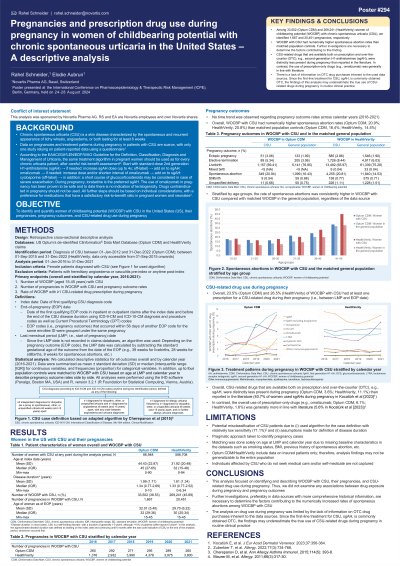Pregnancy and lactation
Session: Poster Session B
(294) Pregnancies and prescription drug use during pregnancy in women of childbearing potential with chronic spontaneous urticaria in the United States – A descriptive analysis
Tuesday, August 27, 2024
8:00 AM - 6:00 PM CEST
Location: Convention Hall II


Rahel Schneider, PhD
Associate Director Epidemiologist
Novartis Pharma AG, Basel, Switzerland, Switzerland- EA
Elodie Aubrun, PharmD, MSc, MPH
Novartis Pharma AG, Basel, Switzerland, Switzerland
Presenting Author(s)
Co-Author(s)
Background: Chronic spontaneous urticaria (CSU) is a skin disease characterized by the spontaneous and recurrent appearance of itchy wheals, angioedema, or both lasting for at least 6 weeks. Data on pregnancies and treatment patterns during pregnancy in patients with CSU are scarce.
Objectives: To identify and quantify women of childbearing potential (WOCBP; aged 15-45 years) with CSU, their pregnancies, pregnancy outcomes, and CSU-related drug use during pregnancy.
Methods: This was a retrospective cross-sectional analysis (2016-2021) in the US Optum Clinformatics Data Mart and HealthVerity (HV). CSU cases were identified by an algorithm based on International Classification of Disease codes. Pregnancies and pregnancy outcomes (livebirth, preterm birth, mixed birth, stillbirth, spontaneous abortion, elective termination, and ectopic pregnancy) were determined based on end of pregnancy (EOP) codes. The last menstrual period (LMP) date, i.e., start of pregnancy, was calculated by subtracting the standard gestational age from the EOP date. Up to four population controls were matched to WOCBP with CSU based on LMP age and calendar year to compare pregnancy outcome rates. Investigated drugs were second-generation antihistamines (sgAH), first-generation AHs, H2-AHs, omalizumab, leukotriene receptor antagonists, systemic glucocorticosteroids, cyclosporine, and other immunosuppressants. All outcomes were assessed overall and by calendar year.
Results: During the analysis period, 33,502 (Optum) and 269,241 (HV) WOCBP with CSU were identified. Overall, 1,667 (Optum) and 20,451 (HV) pregnancies were reported (annual mean: Optum, 278; HV, 3,409). WOCBP with CSU had higher spontaneous abortion rates (Optum, 20.9%; HV, 20.8%) than matched population controls (Optum, 16.4%; HV, 14.5%). Rates of other pregnancy outcomes were similar between the comparison groups. CSU-related drugs that are available both on prescription and over-the-counter (OTC), e.g., sgAH, were distinctly less present during pregnancy (Optum, 3.6%; HV, 11.1%) than reported in the literature. In contrast, the use of prescription-only drugs (e.g., omalizumab; Optum, 6.1%; HV, 1.6%) was generally in line with literature.
Conclusions: Further investigations, preferably in data sources with more comprehensive historical information, are necessary to determine the factors contributing to the notably increased rates of spontaneous abortions among WOCBP with CSU. The analysis on drug use during pregnancy was limited by the lack of information on OTC drug purchases inherent to the data sources. Since the first-line treatment for CSU, sgAH, is commonly obtained OTC, the findings may underestimate the true use of CSU-related drugs during pregnancy in routine clinical practice.
Objectives: To identify and quantify women of childbearing potential (WOCBP; aged 15-45 years) with CSU, their pregnancies, pregnancy outcomes, and CSU-related drug use during pregnancy.
Methods: This was a retrospective cross-sectional analysis (2016-2021) in the US Optum Clinformatics Data Mart and HealthVerity (HV). CSU cases were identified by an algorithm based on International Classification of Disease codes. Pregnancies and pregnancy outcomes (livebirth, preterm birth, mixed birth, stillbirth, spontaneous abortion, elective termination, and ectopic pregnancy) were determined based on end of pregnancy (EOP) codes. The last menstrual period (LMP) date, i.e., start of pregnancy, was calculated by subtracting the standard gestational age from the EOP date. Up to four population controls were matched to WOCBP with CSU based on LMP age and calendar year to compare pregnancy outcome rates. Investigated drugs were second-generation antihistamines (sgAH), first-generation AHs, H2-AHs, omalizumab, leukotriene receptor antagonists, systemic glucocorticosteroids, cyclosporine, and other immunosuppressants. All outcomes were assessed overall and by calendar year.
Results: During the analysis period, 33,502 (Optum) and 269,241 (HV) WOCBP with CSU were identified. Overall, 1,667 (Optum) and 20,451 (HV) pregnancies were reported (annual mean: Optum, 278; HV, 3,409). WOCBP with CSU had higher spontaneous abortion rates (Optum, 20.9%; HV, 20.8%) than matched population controls (Optum, 16.4%; HV, 14.5%). Rates of other pregnancy outcomes were similar between the comparison groups. CSU-related drugs that are available both on prescription and over-the-counter (OTC), e.g., sgAH, were distinctly less present during pregnancy (Optum, 3.6%; HV, 11.1%) than reported in the literature. In contrast, the use of prescription-only drugs (e.g., omalizumab; Optum, 6.1%; HV, 1.6%) was generally in line with literature.
Conclusions: Further investigations, preferably in data sources with more comprehensive historical information, are necessary to determine the factors contributing to the notably increased rates of spontaneous abortions among WOCBP with CSU. The analysis on drug use during pregnancy was limited by the lack of information on OTC drug purchases inherent to the data sources. Since the first-line treatment for CSU, sgAH, is commonly obtained OTC, the findings may underestimate the true use of CSU-related drugs during pregnancy in routine clinical practice.
